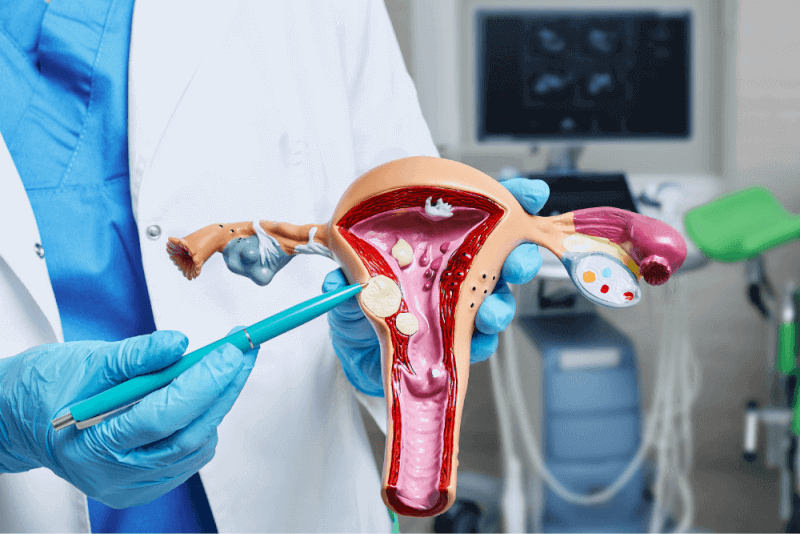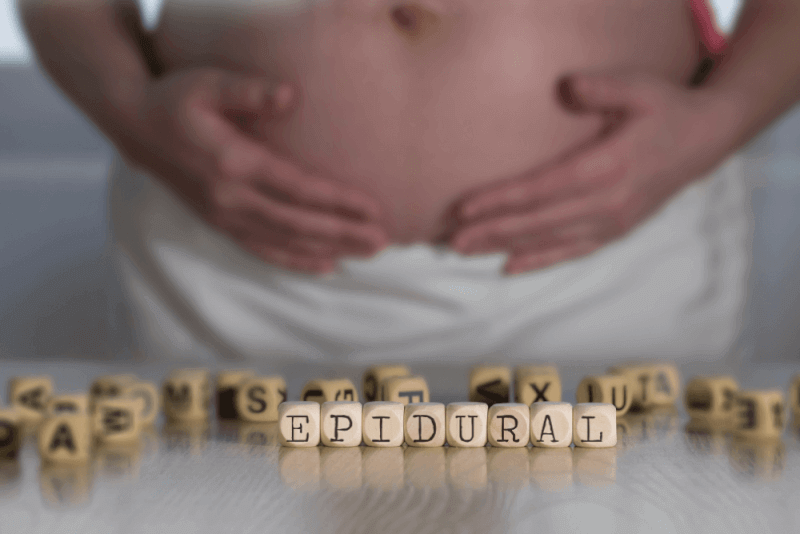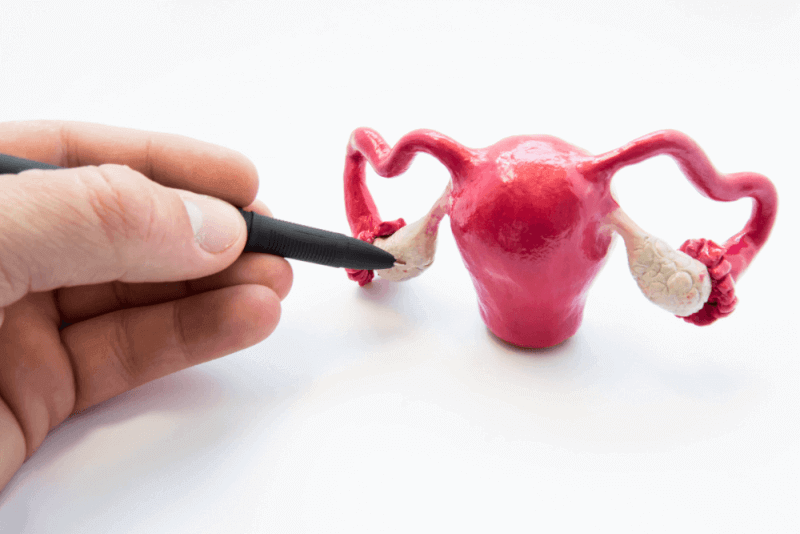Fibroids are smooth, non-cancerous tumors that can develop inside or around the uterus. The exact cause of fibroids is not known, but risk factors include genetics (as they can be inherited within the family), obesity, and advancing age.
Fibroid Symptoms
Fibroid symptoms are clearly evident. There are several observable symptoms that can help a person determine if they have fibroids. One such symptom is painful, heavy, and prolonged menstrual bleeding. These menstrual bleedings can be an indicator of fibroids. Therefore, in such a situation, it is very important to consult a doctor who specializes in this matter immediately.
Fibroid symptoms can also be observed in other ways. These can be listed as follows:
- Increased abdominal pain and pressure sensation due to fibroid pressure
- Complications related to pregnancy or infertility
- Painful intercourse or functional impairment of reproduction
- Frequent urination, inability to fully empty the bladder, and urinary incontinence
- Constipation and similar bowel disorders
If any of these problems are observed, even if mildly, it is very important to visit the nearest healthcare unit. Early diagnosis is always very important.
Causes of Fibroids
The exact causes of fibroids have not yet been determined. However, there are risk factors. One of these is related to the family. A history of fibroids in the family can directly affect the likelihood of an individual developing fibroids. In other words, one of the causes of fibroids is genetic inheritance. Therefore, attention should be paid to whether there is a history of fibroids among family members, i.e., those with blood relations.
Obesity is also among the causes of fibroids. Obesity, which is a cause of many diseases, also significantly increases the risk of developing fibroid tumors. Therefore, combating obesity is very important for health.
In addition, one of the causes of fibroids is advancing age. As age progresses, the risk of encountering different diseases and health problems increases. Among these health problems is fibroids. Advancing age can cause the formation of fibroids.
How Is Fibroid Diagnosis Made?
A person cannot realize they have a problem like fibroids unless they see the symptoms. Even if they see the symptoms, they cannot diagnose fibroids. Fibroid diagnosis can only be made by specialists in the field. Various methods can be tried for this.
A number of tests and procedures are applied to diagnose fibroids. These are as follows:
Blood Tests: Proteins produced by fibroids can be detected by testing blood in the laboratory. In this case, the person can be diagnosed with fibroids. Diagnosed different proteins also help the doctor to get an idea of the severity of the situation.
Urine Tests: Urine tests are also used to detect the proteins produced by fibroids. Urine tests are carried out in a laboratory environment and based on the detected proteins, the person can be diagnosed with fibroids.
Bone Marrow Examination: Bone marrow examination also helps in diagnosing fibroids. For this, a sample must first be taken from the bone marrow. This is done with the help of a needle.
MRI: For the definitive diagnosis of fibroids, the doctor first learns the patient's symptoms. Then, a definite diagnosis can be made with ultrasounds. Thus, it can be easily detected. However, if the mass is large, it may not be fully visible. For this, an MRI is taken. With the MRI device, detailed information about the soft tissues can be obtained.
Fibroid Treatment Methods
Fibroids are treated according to the existing situation. These situations can be listed as the patient's age, the number of fibroids, their location, the placement of the fibroids, and whether the patient wants to have children. The doctor can perform fibroid treatment according to these situations. It should be noted that this treatment is personalized. A treatment method that is problem-free in one patient may not work in another. There are many methods of fibroid treatment. These can be listed below:
Medication
Today, there is no medication that destroys fibroids or prevents their progression. Injection treatment can be used, but this is not a permanent treatment method. Medications used in fibroid treatment create a temporary menopause condition. In addition, they can cause side effects such as osteoporosis, and therefore their use is definitely not recommended for more than 6 months.
Non-Surgical Observation
Small fibroids that do not cause any complaints can be observed at intervals of 3-6 months.
Surgery
Three different methods are used surgically: open method, closed method, and hysteroscopic.
Summary of the Surgery
Duration of the Surgery: 1-3 hours
Type of Anesthesia: General, Spinal, Epidural
Hospital Stay: 1-3 days
Return to Work: 2-6 weeks
Open Method (Laparotomy)
The fibroid is removed through a cesarean incision of approximately 9 or 10 centimeters on the abdomen. The depth or direction of the incision on the navel is determined according to the size or location of the fibroid.
Closed Method (Laparoscopic)
Unlike open surgery, there is no large incision. A 1-centimeter incision is made in the navel, and an optical camera is inserted here. The surgery is completed with 2-3 incisions of 3-10 millimeters made inside the abdomen. Laparoscopic or closed method surgeries are more advantageous for the patient. Because in this case, there is less hospital stay, less pain, faster recovery, and cosmetically more positive results. However, this is not the same for every patient. It may not be a suitable method for every patient.
Hysteroscopic
Similar to the closed method but no external incision is made. A device is inserted through the cervix and the fibroids are removed from the inside. There are no incision marks on the abdomen. The hysteroscopic method is a very effective method that pleases both the patient and the doctor.
Post-Surgery Complaints
Post-surgery complaints for fibroid removal include:
- Risk of bleeding
- Swelling in the groin
- Pain in the groin
- Weakness and fatigue
- Infection of the wound
- Menstrual irregularities
In case of experiencing these issues, it is important to consult a doctor as soon as possible and get the necessary information on the subject.
Effects of Fibroids on the Body
Fibroids do not usually cause serious complications. However, they can significantly affect the quality of life of women.
Heavy, Long, and Painful Menstrual Periods
In the presence of fibroids, sanitary pads may need to be changed within a short period like an hour, or blood clots may be seen. Some individuals may experience bleeding between periods. The experienced bleeding can be severe enough to cause anemia.
Discomfort in the Lower Abdomen
Fibroids can cause pressure, fullness, and a feeling of heaviness in the lower abdomen. As a result, individuals may have difficulty bending forward or lying on their stomach.
Pain in the Lower Abdomen
Less commonly, some individuals experience sharp pain in a specific area. This situation usually improves within two to four weeks.
Bloating
In some individuals, the abdomen may swell enough to appear pregnant.
Back Pain
Occurs when fibroids press on the nerves and muscles in the lower back.
Painful Intercourse
Pain may be felt during intercourse in certain positions or at certain stages of the menstrual cycle.
Urinary Problems
Some individuals may experience frequent urination. It may even be necessary to wake up at night to urinate. Some individuals may also have problems with fully emptying the bladder.
Pressure in the Rectum
Can cause a feeling of needing to defecate. Additionally, pain or constipation can be experienced during defecation.










